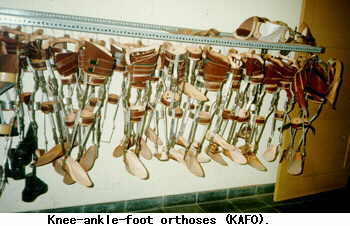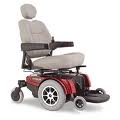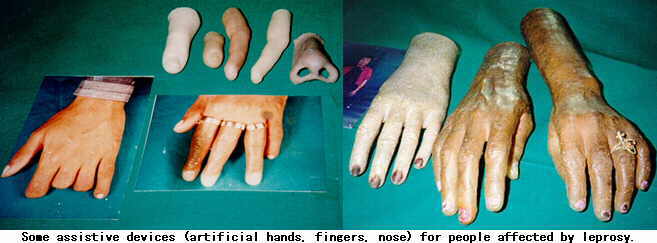Assistive Devices For Physically Disabled
Contents
Orthoses
Orthoses are also known as calipers or braces. Although a brace is generally considered to be larger than a caliper, the two terms are often used interchangeably. This review uses only the more general term orthosis to avoid confusion.
Orthoses have two major purposes: first, to support or maintain a weak limb; and second, to help prevent or correct future deformities and contractures.
Only a few developing countries of the ESCAP region have paid substantial attention to the production of orthoses, in spite of large numbers requiring them. India has addressed the need for orthoses in response to the consequences of polio among many people. In those countries which produce orthoses, manufacturing capacities are not completely used.
A combination of hip knee ankle foot orthosis (HKAFO) and crutches is for rehabilitating paraplegic people in their own surroundings like villages in India. Unlike most wheelchairs, this combination permits them to work in the field and thus remain productive members of their families, as well as allowing for regular exercise.
Metallic orthoses are the most common type of orthosis in developing countries. Conventional metal lower-limb orthoses require the use of special shoes. These shoes are user-specific, so full orthoses can only be produced at a clinic or hospital with trained prosthetic and orthotic technicians. The special leather shoes required are made in the rehabilitation workshops to suit the size and condition of the user's foot. For example, the inside height of the shoe may have to be increased to account for limb shortening.
In India, for people with good biceps muscles and hand- on-knee gait, floor-reaction orthoses (FRO) have been found useful. An FRO is designed so that the toe strikes the ground first; the reaction force from the ground pushes back the knee, making it stable. As a result, users do not require a hand-on-knee gait. Some rehabilitation centres also use PVC pipes (which are used to carry water and are available locally) to produce orthoses.
Prosthetic limbs
They are of two types: Lower Limb Prosthesis and Upper Limb Prosthesis. BK prosthesis are the socket, the shank and the foot-ankle system. A shank is a structural component of a prosthesis which connects the socket to the foot-ankle system and transfers the load of body weight to the foot and the floor. The basic components of an upper-limb prosthesis are:
(a) Socket; (b) Wrist unit; (c) Terminal device or hand; (d) Power transmission system; (e) Forearm; (f) Arm section; (g) Elbow mechanism (for above-elbow amputees); (h) Suspension system.
Wheelchairs of various types
Manual chairs are the basic, tried-and-true mobility devices that have been used for generations. These chairs aren’t anything fancy: they’re usually equipped with a leather seat and back, two large back wheels, and two smaller front wheels. Foot rests are part of the package as well.
To get around with manual wheelchairs, patients either have to be pushed or propel themselves by turning their wheels. These chairs are good for short-term use or for people with a strong companion, but they aren’t the best for long-term, everyday mobility needs.
2.) Electric Wheelchairs
[[File:Images_(5).jpg
These kinds of chairs are motorized, so there’s no need to push or be pushed. Electric wheelchairs come in different varieties: those meant for indoor use, those meant for outdoor use, those built for dual indoor/outdoor use, and those designed to be portable. All electric models come with batteries, which are rechargeable.
Electric wheelchairs are much more expensive than their manual counterparts, but they offer greater freedom of movement. They’re perfect for people who are independent and expect to be in a wheelchair long term.
Tricycles, manual and motorized
Tricycles are devices with three main wheels; they are larger than wheelchairs but operated in similar ways (by hand, electricity or petrol). They are useful for long-distance mobility. In several developing countries of the region, tricycles have enabled people with disabilities to work far from their homes. A tricycle can also be used for carrying extra loads, such as groceries or household items. People in rural areas often prefer tricycles to wheelchairs because tricycles are sturdier and can more easily negotiate rough terrain.
Crutches
Many forms of crutches are used worldwide. Some of the most common types include forearm crutches, axillary or underarm crutches and knee support crutches, among others. Axillary or Underarm Crutches Axillary crutches are the most commonly used form of crutches in countries such as the United States and India. Axillary crutches are generally made up of wood or aluminum, in such a manner that they can be easily adjusted according to the height of the person using them. These crutches are generally used by people who suffer from temporary disabilities or injuries. Axillary crutches generally have padding just beneath the armpits, helping the individual to hold them easily and tightly without difficulty. Forearm Crutches Forearm crutches are the most common form of crutches used by individuals suffering from permanent disabilities. Forearm crutches are designed in a way that the person using them can slip his arm into the cuff and thus hold the grip tightly. The cuff is generally made using either plastic or metal such as aluminum and can be half or full circular in shape, with a V-shaped opening on the front from where the arm can be slid into the crutch.
Devices for people cured of leprosy
Leprosy has two aspects: loss of motor function and loss of peripheral (protective) sensation. Loss of sensation means that people with leprosy cannot sense heat or pain from mild injuries, and sometimes even severe ones. As a result, they must exercise special care and use protective coverings, handles and clothing. The injuries that go unnoticed can easily become infected. If these injuries are not attended to in time, they may lead to the loss of fingers and toes. The loss of these motor functions makes it difficult for people affected by leprosy to engage in many productive activities.
Oven gloves, conventional gloves and mittens can protect hands from injury. Therapeutic splints are made to correct contractures of the inter-phalangeal joints as an aid to mobilizing exercises, massage and other physiotherapy procedures. These splints are made with polyvinyl chloride (PVC) sheets and velcro straps. Some rehabilitation programmes also use soft PVC hose pipes, which are cut lengthwise into two slightly curved gutters. These gutters are attached using velcro straps, sticking plaster or bandages.
People cured of leprosy who have "foot drop" require functional devices to achieve a normal gait. Foot-drop spring shoes are helpful until a surgical correction is carried out. Protective devices are critical for feet without sensation because the foot is the body part most vulnerable to injury.
Footwear should fit closely without being tight. Socks are necessary to reduce the frictional trauma from the upper portion of shoes. Leather is a good material to use in shoes for people with leprosy or cured of it, because it absorbs sweat and moulds itself to make a better fit over time. Since many people affected by leprosy are poor, however, they cannot afford leather shoes.


